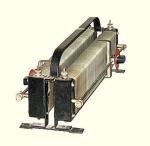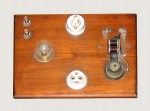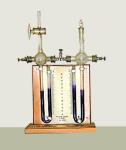

 Menu
Menu
|
Function They are used to change the current intensity or as potentiometers to change the difference of potential. |

| ||
|
|||
|
Description The model is made with a wire wound on two slate prisms supported by the same metallic frame and with two different cursors. The disposition of the terminal boards is such that the two resistances can have connections parallel or in series, allowing a larger use of the apparatus. A data plate applied to the cursor of every rheostat indicates the total resistance and the current in amperes that the rheostat can sustain for a short time without danger. Fifty per cent of the current indicated can be sustained without a great increase of the temperature. | |||
|
Function To have resistances of different quantities. |

| ||
|
|||
|
Description It is formed by a shining wooden case, plug-connections, doubly wound manganin resistances protected by an insulating varnish. Precision 1% for the resistance from 10000 to 100ohm, 0.2% from 10 to 1 ohm; 0.5% for those of 0.1 ohm. | |||
|
Function To change the range of the galvanometers. |

| ||
|
|||
|
Description It is made of a cylindrical brass case with an ebonite lid. The ends of the resistances in the case terminate with brass blocks and are inserted in parallel on the galvanometer circuit with plugs. | |||
|
Function To measure resistances. |

| ||
|
|||
|
Description A calibrated silver nickel wire is stretched on a 1.20 m mahogany basis that lies on a one-meter millimetric scale. A cursor slides on the wire. Two copper wires applied under complete the rectangle and are collected to the terminal boards of the unknown resistance, of the calibrated resistance and of the cell. The circuits are indicated with very visible white lines. | |||
|
Function To study the resistances. |

| ||
|
|||
|
Description Four lamp-holders are mounted on the same table with extreme and intermediate binding posts and with a general switch. In this way the lamps can be connected in series and in parallel. | |||
|
Function To study the electric current. |

| ||
|
|||
|
Description On a rectangular table there are: a lamp-hold with a lamp, an outlet, a switch, a bell and two binding posts. | |||
|
Function It is used as a light source in various experiments. |

| ||
|
|||
|
Description The supports of the two carbons are mounted on a glass column. The top carbon moves vertically. The ensemble is mounted on a cast iron tripod. We can use carbons with a diameter up to six millimetres. | |||
|
Function To show the transformation of the electric energy into heat. |

| ||
|
|||
|
Description Two spirals of niccolite, one with a resistance twice as the other, are stretched on the two balloons, each one of which communicating with a tube. After opening the upper keys, we pour a coloured liquid into the manometer, and then we close the keys. We send the current into the two spirals connected in series and we observe a different shift in the two manometers. The middle binding post allows using the two spirals separately to demonstrate that the quantity of developed heat is directly proportional to the square of the current intensity for the same conductor. For the two experiences a tension of 4 volt is enough, with a rheostat in series to regulate the current intensity. | |||